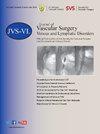Wound-healing and onboard care during long-duration human deep space exploration from a surgical perspective through the lens of a scoping review
IF 2.8
2区 医学
Q2 PERIPHERAL VASCULAR DISEASE
Journal of vascular surgery. Venous and lymphatic disorders
Pub Date : 2025-04-15
DOI:10.1016/j.jvsv.2025.102249
引用次数: 0
Abstract
Objective
The aim of this study was to develop a bridge between the fields of aerospace medicine and vascular surgery, and to emphasize the need for leading experts in vascular medicine, interventional radiology, and surgery to address the critical human spaceflight research gaps highlighted by the National Aeronautics and Space Administration (NASA).
Methods
A scoping review following the Preferred Reporting Items for Systematic Reviews and Meta-Analyses (PRISMA) guidelines was conducted on literature published between 2000 and 2024. A well-defined search strategy was employed for keyword searches across multiple databases, including PubMed, Scopus, Cochrane, Embase, the NASA Life Science Data Archive, NASA technical reports, and Google Scholar.
Results
Our review identified 125 relevant studies. These included 30 studies on general health conditions in space and wound healing, 38 addressing risk factors associated with the space environment, and 57 studies examining prevention and treatment options. These findings address NASA’s identified gaps in wound care capabilities (ExMC 4.07), contribute to defining the potential list of medical conditions that could arise during deep-space missions (ExMC 4.24, Med07, Med12, Medical-101), and serve as a milestone for developing integrated exploration medical system models for missions to the Moon and Mars (Medical-501).
Conclusions
Many of the identified NASA knowledge gaps—some of which have even been marked as closed due to a lack of research in the field—cannot be effectively addressed without bridging aerospace medicine with related disciplines, such as vascular surgery and chronic wound care.
伤口愈合和机载护理在长时间的人类深空探索从外科的角度通过范围审查的镜头。
目的:本研究的目的是在航空航天医学和血管外科领域之间建立一座桥梁,并强调需要血管医学、介入放射学和外科方面的顶尖专家来解决美国国家航空航天局(NASA)强调的人类航天研究的关键空白。方法:根据系统评价和荟萃分析的首选报告项目(PRISMA)指南对2000年至2024年间发表的文献进行范围审查。一个定义良好的搜索策略用于跨多个数据库的关键字搜索,包括PubMed、Scopus、Cochrane、Embase、NASA生命科学数据档案、NASA技术报告和谷歌Scholar。结果:我们的综述确定了125项相关研究。其中包括30项关于空间一般健康状况和伤口愈合的研究,38项研究与空间环境有关的风险因素,57项研究审查预防和治疗方案。这些发现解决了NASA在伤口护理能力方面的差距(ExMC 4.07),有助于确定深空任务期间可能出现的潜在医疗条件清单(ExMC 4.24, Med07, Med12, medical -101),并作为开发月球和火星任务综合探索医疗系统模型的里程碑(medical -501)。结论:如果不将航空航天医学与相关学科(如血管外科和慢性伤口护理)联系起来,许多已确定的NASA知识缺口(其中一些甚至由于缺乏该领域的研究而被标记为已关闭)无法有效解决。
本文章由计算机程序翻译,如有差异,请以英文原文为准。
求助全文
约1分钟内获得全文
求助全文
来源期刊

Journal of vascular surgery. Venous and lymphatic disorders
SURGERYPERIPHERAL VASCULAR DISEASE&n-PERIPHERAL VASCULAR DISEASE
CiteScore
6.30
自引率
18.80%
发文量
328
审稿时长
71 days
期刊介绍:
Journal of Vascular Surgery: Venous and Lymphatic Disorders is one of a series of specialist journals launched by the Journal of Vascular Surgery. It aims to be the premier international Journal of medical, endovascular and surgical management of venous and lymphatic disorders. It publishes high quality clinical, research, case reports, techniques, and practice manuscripts related to all aspects of venous and lymphatic disorders, including malformations and wound care, with an emphasis on the practicing clinician. The journal seeks to provide novel and timely information to vascular surgeons, interventionalists, phlebologists, wound care specialists, and allied health professionals who treat patients presenting with vascular and lymphatic disorders. As the official publication of The Society for Vascular Surgery and the American Venous Forum, the Journal will publish, after peer review, selected papers presented at the annual meeting of these organizations and affiliated vascular societies, as well as original articles from members and non-members.
 求助内容:
求助内容: 应助结果提醒方式:
应助结果提醒方式:


